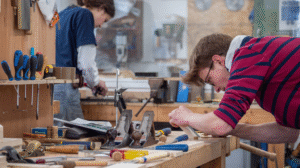Furniture isn’t just about tables, chairs, or beds — it’s about comfort, creativity, and function. Designing and building furniture can be a highly satisfying skill, especially if you love working with your hands or want to create custom pieces for your home.
This article is a complete beginner’s guide to furniture design and construction, covering everything from tools and materials to simple projects you can try at home.

Section 1: Why Learn Furniture Design and Construction?
Whether you’re a DIY lover or just starting a new hobby, furniture building has a lot to offer:
-
🧰 Hands-on creativity
-
💰 Save money by building instead of buying
-
🏡 Customize furniture to fit your space
-
♻️ Use reclaimed materials for eco-friendly projects
-
🧠 Learn problem-solving and craftsmanship
Section 2: Understanding Basic Furniture Design Principles
Before picking up tools, it’s important to learn the basics of design:
1. Functionality
What purpose will the furniture serve? (e.g., seating, storage, decoration)
2. Ergonomics
Make sure your piece is comfortable and safe for daily use.
3. Proportions & Balance
Well-balanced designs are not just beautiful — they’re also stable.
4. Aesthetics
Choose a style — modern, rustic, minimalistic, vintage, etc.
5. Materials
Each material behaves differently. Beginners usually start with wood.
Section 3: Tools Every Beginner Needs
You don’t need a full workshop to start. Here’s a list of essential tools:
🛠️ Hand Tools:
-
Measuring tape
-
Carpenter’s square
-
Claw hammer
-
Handsaw
-
Screwdrivers
-
Chisels
-
Sandpaper (various grits)
🔧 Power Tools (Optional for beginners):
-
Electric drill
-
Jigsaw or circular saw
-
Orbital sander
-
Nail gun (for faster assembly)
Start with hand tools and gradually upgrade as your skills grow.
Section 4: Choosing the Right Materials
As a beginner, stick to materials that are easy to work with:
✅ Softwoods (easier to cut):
-
Pine
-
Cedar
-
Fir
✅ Plywood or MDF:
Good for indoor furniture, budget-friendly, and stable.
❌ Avoid hard-to-work woods like oak or walnut in the beginning.
Other materials (optional):
-
Screws, nails, glue
-
Wood filler
-
Varnish or paint
-
Hinges, handles, or knobs (for cabinets/drawers)
Section 5: Simple Furniture Projects to Start With
Don’t aim for a full dining table on day one. Start small with these beginner-friendly projects:
1. Wooden Bench
A flat top, four legs — perfect for practicing basic joins and finishes.
2. Bookshelf
Teaches cutting, joining, and leveling.
3. Coffee Table
Learn how to frame a top and attach legs.
4. Storage Crate
Simple box design using screws or nails.
5. Wall-mounted Shelf
Quick project that uses just a few cuts and wall brackets.
Each project teaches you something new — cutting, measuring, sanding, and finishing.
Section 6: Understanding Joinery Basics
Joinery refers to how different parts of your furniture fit together.
Here are 3 easy joinery techniques for beginners:
-
Butt Joint: Two pieces joined at right angles using screws/nails.
-
Dowel Joint: Wooden dowels placed in drilled holes for stronger grip.
-
Pocket Hole Joinery: Angled screws for clean, strong joints (needs jig).
Use wood glue with almost every joint for durability.
Section 7: Step-by-Step Furniture Building Process
Let’s go over a general 6-step process for any beginner furniture project:
✅ 1. Planning & Sketching
Draw your idea. Measure your space and define dimensions.
✅ 2. Material List
Write down all materials needed: wood types, screws, glue, etc.
✅ 3. Cutting Wood
Use a saw or get it cut at a hardware store. Label each piece.
✅ 4. Assembly
Use clamps, glue, and screws to attach parts. Follow your sketch plan.
✅ 5. Sanding
Use medium and fine grit sandpaper to smooth all surfaces and edges.
✅ 6. Finishing
Apply paint, stain, varnish, or wax for protection and beauty.
Section 8: Common Mistakes Beginners Should Avoid
-
❌ Skipping measurements
-
❌ Using the wrong type of wood for weight/stability
-
❌ Over-tightening screws (can crack the wood)
-
❌ Not allowing glue or paint to dry properly
-
❌ Not sanding before painting
Mistakes are part of learning — always test on scrap wood first.
Section 9: Where to Learn More
To go beyond the basics:
-
📺 YouTube Channels: DIY Creators, Fix This Build That, Woodworking for Mere Mortals
-
📚 Books: “The Complete Manual of Woodworking” or “DIY Furniture”
-
📱 Apps: SketchUp (for 3D planning), Pinterest (design ideas)
-
🌐 Communities: Reddit (r/woodworking), Facebook groups, local classes
Section 10: Turning It Into a Hobby or Career
Once you’ve built confidence:
-
Make custom furniture for friends or clients
-
Sell on Etsy or local markets
-
Offer furniture repair services
-
Create a YouTube channel or blog about your projects
Conclusion
Learning furniture design and construction as a beginner doesn’t require a fancy workshop or years of experience. All you need is the right knowledge, a few tools, and the willingness to try.
Start small, be patient with mistakes, and enjoy the process of creating something useful with your own hands. Whether it’s a basic shelf or a stylish bench, every piece you build takes you one step closer to mastering this valuable skill.
